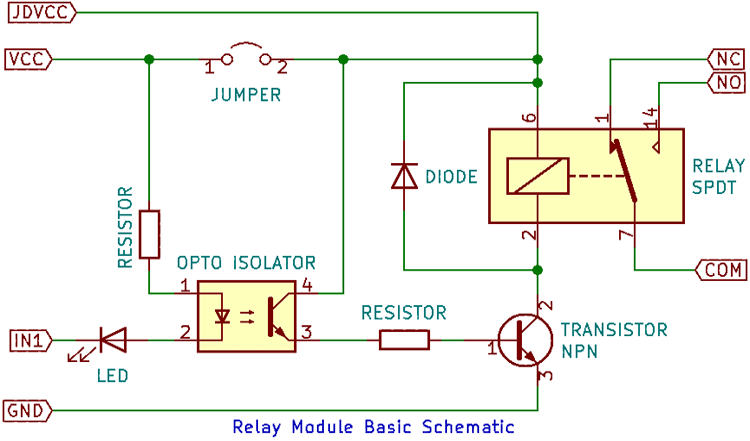AED 18.95
Description
This is a 5V 2-ch relay interface board. It can be used to control a variety of high-current appliances and equipment. It has high-current relays that operate at AC250V 10A or DC30V 10A and a standard interface that can be controlled directly by the microcontroller.. optical isolators are built into the module. it keeps high voltage from affecting the system receiving the signal.
Package Includes:
- 1 x 2ch Relay Module High Trigger With Optocoupler
Features:
- Each relay features an LED indicator
- Color: Black
- Optocoupler included on the board for reducing the distortion.
- One normally closed contact and one normally open contact
- High-impedance controller pin
- Power supply indicator and Control indicator lamp
- The power source can be configured with a jumper located on the board.
Description:
This is a 5V 2ch relay interface board, It can be used to control a variety of high-current appliances and equipment. It has high-current relays with a standard interface that can be controlled directly by the microcontroller. optical isolators are built into the module. it keeps high voltage from affecting the system receiving the signal. An optocoupler is a component that uses light to transfer electrical signals between two states of isolation circuits while preventing high voltage from affecting the receiving system. The relay's maximum contact is AC250V 10A and DC30V 10A, and microcontrollers can be connected directly to the standard interface. Safety features are provided by red working status indicator lights. MCU control, industrial sector control, PLC control, and intelligent home control are all common applications.
Principle of Work:
A relay is a type of switch that can be controlled with an electrical signal. It is a way to open or close a circuit in this case via a signal from the connected microcontroller. The relay isolates the circuit on the device you want to control from the device that's controlling it. and High-level triggered will allow the current to go through the power line when the control signal is VCC or High. optocoupler on the other hand makes real photo isolation between the relay and the MCU which is very good to minimize the distortion from the other side
Pinout of the Module:

GND - Connect 0V of the external Power Supply.
SGND - Connect 0V of the Arduino.
IN1 - Controls Relay 1, active High! The relay will turn on when this input connecter to the High
IN2 - Controls Relay 2, active High! The relay will turn on when this input connecter to the High
VCC - Connect 5V to this pin. Is used to power the optocouplers
NC: you connect your application here if you want it to be working all the time and stop when you attach input to GND
COM: common always connected
Applications:
- Relay Drive from External Contacts.
- LED Series and Parallel Connections.
- Electronic Circuit Drive by Means of a Relay.
- Home automation
- Battery backup
- High current load switching
Circuit:
Two distinct loads have been connected to the relay's NO terminals. Each relay's common terminal has a live wire connected to it. When the relays are activated, the load is powered and connected to the live wire. This configuration can be reversed by connecting the load to the NC terminal, which keeps the load powered on until the relay is activated.
Library:
This Module doesn't need a library to work.
Code:
void setup() {
// initialize digital pin LED_BUILTIN as an output.
pinMode(2, OUTPUT);
pinMode(3, OUTPUT);
}
// the loop function runs over and over again forever
void loop() {
digitalWrite(2, HIGH); // turn the LED ON by making the voltage HIGH delay(1000);
delay(1000); // wait for a second
digitalWrite(3, HIGH); // turn the LED ON by making the voltage HIGH delay(1000);
delay(1000); // wait for a second
digitalWrite(2, LOW); // turn the on off(LOW is the voltage level)
delay(1000); // wait for a second
digitalWrite(3, LOW); // turn the on off (LOW is the voltage level)
delay(1000); // wait for a second
}
Technical Details:
- 2 Channel
- Supply voltage – 3.75V to 6V
- Trigger current – 5mA
- Current when relay is active - ~70mA (single), ~140mA (both)
- Relay maximum contact voltage – 250VAC, 30VDC
- Relay maximum current – 10A
Resources:
Comparisons:
The Active High Triggered Relay Module is the easiest kind of relay board to work with it works as you expect it to work so when it's on the application on the other side of the relay is on (not like the Low Triggered Realy workers exactly the opposite) and the optocoupler gives you the advantage of easy connection which it doesn't need lots of thinking because the relay is latching in a separate way from your MCU using the phototransistor in it so it's easier than the relays with no optocouplers like this item (Relay Module Board 1 Channel 5V 10A Low-Level Trigger).
This kind of relay board has so many advantages like being able to withstand large inrush currents and high mechanical structure reliability, not being susceptible to the external electromagnetic environment, and being able to carry high voltage, and high current load but still, it has multiple disadvantages to the SSR Boards that they are slower than SSRs at 5 to 15ms and it has a larger package size, are not suitable for small projects and electromechanical relays tend to have a shorter life than other types of relays due to mechanical wear if you interested in SSRs you can get it from here

